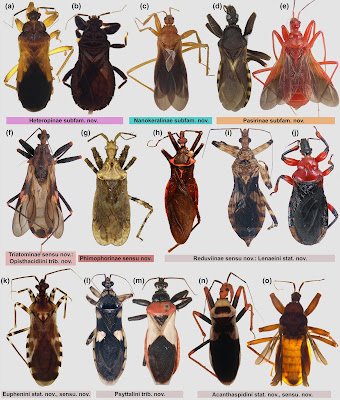 |
| Assassin bug diversity and examples of unique morphological and behavioural adaptations found across the family. in Masonick, Knyshov, Gordon, Forero, Hwang, ... et Weirauch, 2025. |
Abstract
Assassin bugs (Hemiptera: Reduviidae Latreille) comprise not only one of the largest radiations of predatory animals (22 subfamilies; >6,800 spp.) but also include the medically important kissing bugs (Triatominae Jeannel). Reduviidae are morphologically diverse, engage in an astounding array of predatory strategies and have evolved some of the most unique anti-predator and stealth techniques in the animal kingdom. While significant progress has been made to reveal the evolutionary history of assassin bugs and revise their taxonomy, the non-monophyly of the second largest assassin bug subfamily, Reduviinae Latreille, remains to be addressed. Leveraging phylogenomic data (2,291 loci) and 112 morphological characters, we performed the first data- and taxon-rich (195 reduvioid taxa) combined phylogenetic analysis across Reduvioidea and reconstructed morphological diagnostic features for major lineages. We corroborated the rampant polyphyly of Reduviinae that demands substantial revisions to the subfamilial and tribal classification of assassin bugs. Our new classification for Reduviidae reduces the number of subfamilies to 19 and recognizes 40 tribes. We describe three new subfamilies to accommodate distantly related taxa previously classified as Reduviinae (Heteropinae subfam. nov., Nanokeralinae subfam. nov., and Pasirinae subfam. nov.). Triatominae sensu nov. are expanded to include closely related predatory reduviine genera. Cetherinae Jeannel, Chryxinae Champion, Pseudocetherinae Villiers, Salyavatinae Amyot & Serville and Sphaeridopinae Amyot & Serville are treated as junior synonyms of Reduviinae sensu nov. Epiroderinae Distant are synonymized with Phimophorinae Handlirsch sensu nov. and Bactrodini Stål stat. nov. are reclassified as a tribe of Harpactorinae Amyot & Serville. Psophidinae Distant is treated as a valid subfamily. This new classification represents a robust framework for future taxonomic and evolutionary research on assassin bugs.
Keywords: ancestral state reconstruction, Cimicomorpha, phylogenetic systematics, revised classification, taxonomy, true bugs
Paul K. Masonick, Alex Knyshov, Eric R. L. Gordon, Dimitri Forero, Wei Song Hwang, Rochelle Hoey-Chamberlain, Tatiana Bush, Stephanie Castillo, Madison Hernandez, Jamie Ramirez, Samantha Standring, Junxia Zhang and Christiane Weirauch. 2025. A Revised Classification of the Assassin Bugs (Hemiptera: Heteroptera: Reduviidae) based on combined analysis of phylogenomic and morphological data. Systematic Entomology. DOI: doi.org/10.1111/syen.12646 [17 July 2024]

